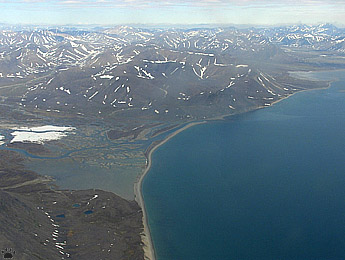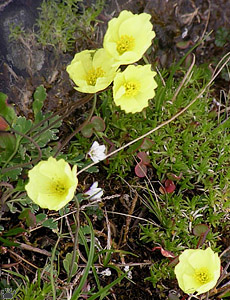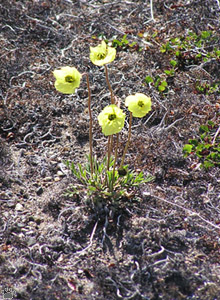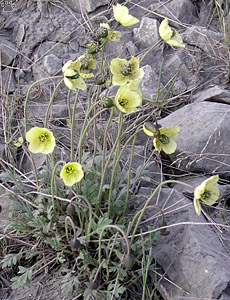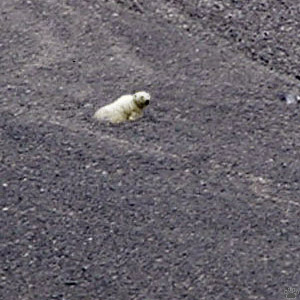From
a rearranged translation of Vladimir
Dinets original pages to norwegian,
with supplements.

Klikk på flagg for norsk versjon
 Summer
night at Cross Bay, Chukotka, Russia.
Summer
night at Cross Bay, Chukotka, Russia.
|
In many places along the coast of Chukotka, especially
in the eastern part, mountains come close to the sea,
forming rocky capes separated by deep fjords.
Four beautiful fjords branch off Cross Bay, nine are located further
east, and four - in southern Chukotka

Cross Bay. |

Topper i Iskatenfjellkjeden rundt Cross Bay. |
 Cross
Bay near Egvenkinot.
Cross
Bay near Egvenkinot.
|
Steep shores of those fjords shelter southern slopes from northern
winds, but not from drifting snow.
The result is high climate and habitat diversity in small areas

Coast of Etelkuyum Bay - one of Cross Bay fjords. |

Glaucous gull, Larus hyperboreus, Etelkuyum Bay. |

Arctic mountain-avens, Dryas octopetala, Itelkuyum Bay. |

Alpine mountain-avens, Dryas integrifolia, Itelkuyum
Bay. |
One of the keynote species of the north temperate alpine regions
is mountain avens or Dryas. Anyone hiking in the high mountains
of North American Rockies, European Alps or Caucasus, Russian
Urals and even the slopes of Siberia and Alaska, are likely
to encounter this plant. They are a dominant plant of the unique
Irish Burrens, as well as the limestone barrens of Newfoundland.
Mountain avens even make it well into the Arctic Circle, and
in fact, grow as far north as there is land! The genus gets
its name from the Greek oak-nymph called 'Dryas'. The genus
name refers to the similarity of the leaves of mountain avens
to those of oaks. Mountain avens belong to the rose family.
Plants are woody and prostrate forming extensive mats that often
root at intervals, lending this plant the effective ability
to stabilize mountain slopes and river gravels. In mountainous
regions, mountain avens typically grow on limestone substrates,
but in the high Arctic they are not so restricted.
Source: http://davesgarden.com/guides/articles/view/1924/
 Flowers
doesn't blossom for ever......
Flowers
doesn't blossom for ever......
but they will be back next spring. |
Mountain
avens, Dryas
octopetala (common
names include white dryas, and white dryad) is an arctic-alpine
flowering plant in the family Rosaceae. It is a small prostrate
evergreen subshrub forming large colonies, and is a
popular flower in rock gardens. The specific epithet octopetala
derives from the Greek octo (eight) and petalon
(petal), referring to the eight petals of the flower, an unusual
number in the Rosaceae, where five is the normal number.
However flowers with up to 16 petals also occur naturally.
The stems are woody, tortuous, with short, horizontal rooting
branches. The leaves are glabrous above, densely
white-tomentose beneath. The flowers are produced on stalks
3–10 cm (1.2–3.9 in) long, and have eight creamy
white petals. The style is persistent on the fruit with white
feathery hairs, functioning as a wind-dispersal agent.
The feathery hairs of the seed head first appear twisted together
and glossy before spreading out to an expanded
ball which the wind quickly disperses.
It grows in dry localities where snow melts early, on gravel
and rocky barrens, forming a distinct heath community
on calcareous soils.
Source: http://en.wikipedia.org/wiki/Dryas_octopetala |
As a result of the diverse conditions and lack of complete glaciation
in recent past,
these fjords have the highest botanical diversity anywhere in the
Arctic -
over 600 species of vascular plants

Cross Bay near Egvenkinot. |

Tundra poppy, Papaver lapponicum orientale,
Cross Bay. |
Vascular plants (also known as tracheophytes or higher
plants) are those plants that have lignified tissues for conducting
water, minerals, and photosynthetic products through the plant.
Vascular plants include the clubmosses, Equisetum, ferns,
gymnosperms (including conifers) and angiosperms (flowering
plants). Scientific names for the group include Tracheophyta
and Tracheobionta.
Vascular plants are distinguished by two primary characteristics:
1.Vascular plants have vascular tissues which circulate resources
through the plant. This feature allows vascular plants to evolve
to a larger size than non-vascular plants, which lack these
specialized conducting tissues and are therefore restricted
to relatively small sizes.
2.In vascular plants, the principal generation phase is the
sporophyte, which is usually diploid with two sets of
chromosomes per cell. Only the germ cells and gametophytes are
haploid. By contrast, the principal generation phase
in non-vascular plants is usually the gametophyte, which is
haploid with one set of chromosomes per cell. In these plants,
generally only the spore stalk and capsule are diploid. So
now you know the two primary characteristics.....
Source: http://en.wikipedia.org/wiki/Vascular_plant
 Papaver
lapponicum
Papaver
lapponicum |
Papaver lapponicum is a species of poppy known by
the common names Lapland poppy. It is endemic to Lapland
and western Siberia.
Papaver is a genus of 70–100 species of frost-tolerant
annuals, biennials, and perennials native to temperate and cold
regions of Eurasia, Africa and North America. It is the type
genus of the poppy family, Papaveraceae.
The flowers have two sepals that fall off as the bud opens,
and four (or up to six) petals in red, pink, orange, yellow,
or lilac. There are many stamens in several whorls around a
compound pistil, which results from the fusion of carpels.
The stigmas are visible on top of the capsule, and the number
of stigmas corresponds to the number of fused carpels.
The ovary later develops in a dehiscing capsule, capped by the
dried stigmas. The numerous, tiny seeds escape with
the slightest breeze through the pores of the capsule.
The typical Papaver Gynoecium is hypogenous with a globular
ovary. The flower is characteristically absent for the typ
e species Opium Poppy, and several others, although those with
a style do exist.[3] The sessile plate-like stigmata lies on
top of the ovary. Pollen-receptive surfaces. The characteristic
fruit type of Papaver is the unilocular capsule.
The stigmatic disc rests on top of the capsule, and beneath
it are dehiscent pores or valves.
Source: http://en.wikipedia.org/wiki/Papaver
|
|
|
|
|
|
Tundra
poppy, Papaver lapponicum, is highly polymorphic. Left
to right: Golden Ridge, Belyaka Spit, Cross Bay.
|
South- facing fjord slopes are also the best place to look for
rare butterflies.
Most have their wings torn by strong winds

Kamchatka swallowtail,
Papilio machaon kamchatkensis, Golden Ridge. |

Kamchatka swallowtail , Golden Ridge. |
Swallowtail butterflies are large, colorful butterflies
that form the family Papilionidae. There are over 550
species, and though
the majority are tropical, members of the family are found on
all continents except Antarctica. The family includes the largest
butterflies in the world, the birdwing butterflies of Australia
(genus Ornithoptera). No picture - it doesn't belong
here.
Swallowtails differ from all other butterflies in a number of
anatomical traits. Most notably, their caterpillars possess
a unique organ
behind their heads, called the osmeterium. Normally hidden,
this forked structure can be everted when the caterpillar is
threatened,
or forced out with a gentle squeeze, and emits smelly secretions
containing terpenes. The adults are often tailed like the forked
tail
of some swallows, giving the insect its name.
Source: http://en.wikipedia.org/wiki/Swallowtail_butterfly |

Eversmann's parnassian, Parnassius eversmanni, Cross
Bay.
|

Orb-weaving spider, Araneus sp., Golden Ridge.
|
The "typical" orb-weaver spiders (family
Araneidae) are the most common group of builders
of spiral wheel-shaped webs often found in gardens, fields and
forests. Their common name is taken from the round shape of
this typical web, and the taxon was formerly also referred to
as the Orbiculariae.
Orb-weavers have eight similar eyes, legs hairy or spiny and
no stridulating organs. The Araneidae family is cosmopolitan,
including many well-known large or brightly colored garden spiders.
There are 3,006 species in 168 genera worldwide,
making Araneidae the third largest family of spiders known (behind
Salticidae and Linyphiidae). The orb-weavers include
over 10,000 species and make up about 25% of spider diversity.
Source: http://en.wikipedia.org/wiki/Orb-weaver_spider
|
Polar bears leave the mainland in summer, but some get stuck and
wait out the heat
on high mountain slopes above cold fjords.
 Summer
night at Cross Bay, Chukotka, Russia.
Summer
night at Cross Bay, Chukotka, Russia. |
Part 9. South of Chukotka
Back to
part 7
All
pictures, unless otherwise stated, Copyright © Vladimir
Dinets
|





